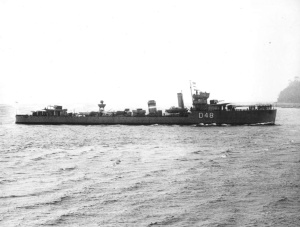HMS Vidette (D48)
 |
|
| History | |
|---|---|
| Name: | HMS Vidette |
| Builder: | Alexander Stephens & Sons Limited |
| Laid down: | 1 February 1917 |
| Launched: | 28 February 1918 |
| Completed: | 27 April 1918 |
| Fate: | Sold for scrapping, 1947 |
| General characteristics | |
| Class and type: | Admiralty V class destroyer |
| Service record | |
| Part of: |
|
| Operations: | |
| Victories: | |
HMS Vidette (D48) was an Admiralty V class destroyer of the Royal Navy. Built at the end of the First World War, she served in the final months of that conflict, and saw extensive service in the inter war years and in World War II. She was an effective convoy escort and U-boat killer, being credited with the destruction of five U-boats during the Battle of the Atlantic.
Vidette was ordered on under the 1916-17 War Emergency Programme from Alexander Stephens & Sons Limited in Linthouse, Govan. She was laid down on 1 February 1917, was launched on 28 February 1918, and completed on 27 April the same year.
Vidette served with the Grand Fleet to the end of World War I, and was placed in Reserve in 1923. She spent most of the 1920s and 1930s in reserve, but was brought back to active service in 1939 for World War II. In the picture, taken probably in 1939, she is wearing the funnel bands of the 16th Destroyer Flotilla based at Portsmouth; one red over one white. Early in the war she would have landed the after set of torpedo tubes and shipped a QF 12 pounder 12 cwt gun in lieu.
Vidette received several refits and modifications during her service career. In 1923 she was equipped with submarine detection gear (ASDIC), one of the first British warships so outfitted. In 1939 she was refitted for convoy escort and anti-submarine warfare duty. In October 1941 during a refit at Gibraltar she received Type 286M radar. In September 1942 she was converted to a Long-Range Escort, landing her torpedo equipment and receiving additional anti-submarine weapons. She also had boilers removed and replaced with fuel tanks, reducing her overall speed but enhancing her range and endurance.
...
Wikipedia
